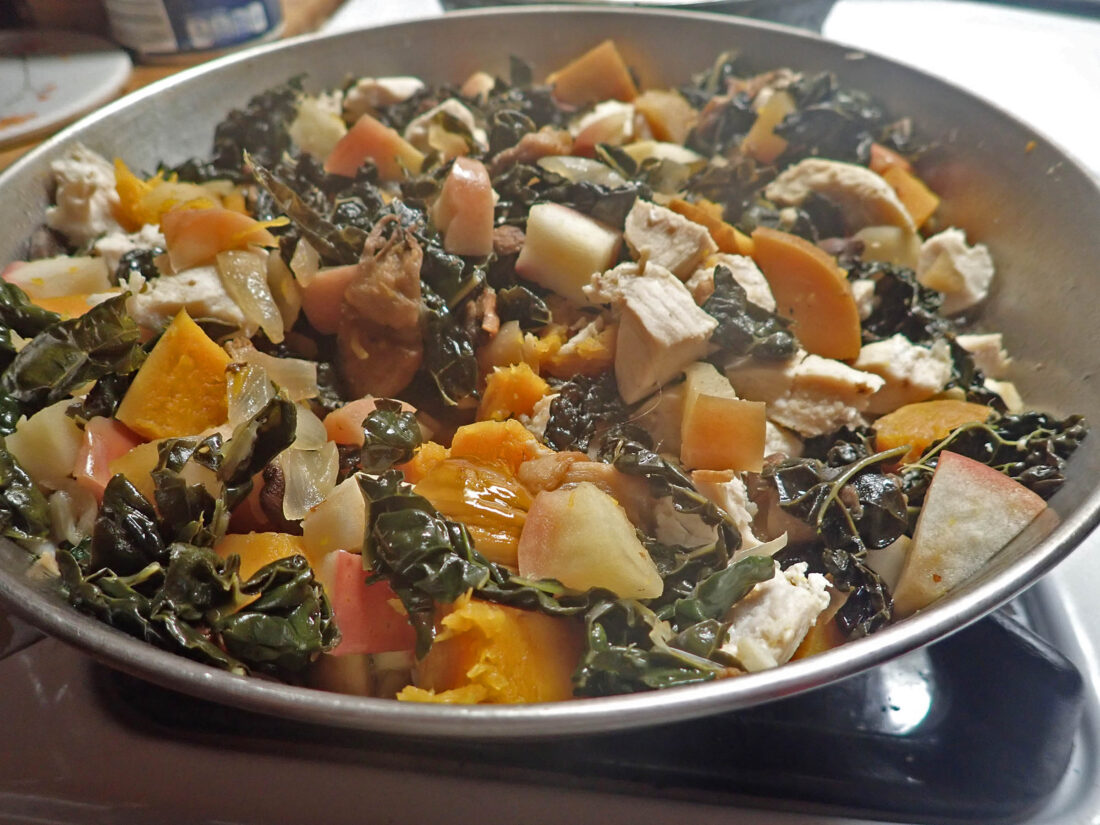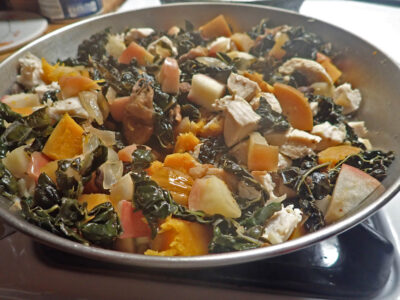In season: winter greens, winter squash

Squash, kale, apple and chicken skillet (Provided photo — Yvona Fast)
Chilly, gray autumn brings fresh fall flavors — tough, pungent greens like kale and collards; sweet winter squash; sweet and tart apples; and sweet roots like carrots and beets.
Dark green, frilly leaves of kale or collards and graceful stems topped with green cabbage roses (Brussels sprouts) are abundant. Descended from wild cabbage cultivated in the eastern Mediterranean more than 4,000 years ago, kale was well known in ancient Greece. The Romans were fond of both.
Like other cruciferous vegetables, kale, collards and Brussels sprouts help fight cancer and heart disease. They’re rich in vitamins A and C, and an excellent source of potassium, phosphorus and fiber. Sprouts also contain generous amounts of the B vitamins folate, thiamine and riboflavin, while kale is an excellent source of calcium and iron.
Kale and collards need to cook longer than most other greens to become tender. Their strong flavors go well with acids, so season with a little vinegar or lime juice. These greens combine well with sweet squash and sweet-tart apples.
Winter squash come in many colors, shapes and sizes. All have firm flesh and a hard shell. Mildly sweet and slightly nutty, winter squash goes well with tart or sharp flavors, like pungent winter greens. Although there are subtle variations in taste and texture, most varieties can be used interchangeably in recipes.
The most common is Butternut squash, with a flavor similar to sweet potatoes. Its oval shape resembles a vase, with a long neck and a seed-containing bulb. Similar, but smaller and sweeter, is the honey nut squash. Delicata squash is thin and long, with a yellow and green striped shell. These three have a relatively thin skin, and peeling is optional.
Another common squash is the acorn. Oval with large ridges, it’s shaped like a huge acorn with a point at the bottom. It’s about 5 to 8 inches long, 4 to 5 inches across, and weighs 1 to 2 pounds. The ridges make it hard to peel, so it is often served stuffed. An easy way to prepare this squash is to prick the skin a few times with a knife, then cook it in the microwave for 20 minutes. Cool until you’re able to handle it, then slice it in half, remove the seeds and proceed with the recipe.
Hubbards are the largest squashes varying in color, they’re the size of pumpkins, but with ridges. These are best roasted for their dry, light and mild-tasting pulp. Kabocha, with a deep green shell and dry, flaky, light, mild flesh, is a favorite among connoisseurs. Sweet dumpling is sweet and — um — shaped like a dumpling.
This complex carbohydrate vegetable — botanically a fruit — is a concentrated food, rich in carbohydrates and natural sugars. It is easy to digest, so is often given to babies. Nutritionally, it is high in fiber, vitamin A, and many other vitamins and minerals. It is easy to cook and can be prepared in a variety of ways — roasting, steaming, casseroles, pies, soups — with seasonings from sweet to spicy. One large squash can make several meals, so you may want to freeze some. And this time of year, squashes are abundant and relatively inexpensive.
Squashes originated in Mexico and Central America. They were probably the first food cultivated by the Indians, even before corn and beans — the three food groups that make up the Native American triad of food staples. Squash seeds dating to between 9,000 and 4,000 B.C have been found at archeological digs in Mexico. Although most plentiful in autumn, it is called winter squash because it will keep for weeks if stored in a cool, dark, dry place. But don’t refrigerate it; temperatures below 50 degrees will cause chilling injuries. Dry, hot air will cause it to lose moisture.
To cook a whole squash, pierce the skin in several places, place it on a baking sheet and cook at 350 degrees F for 1 hour, or longer, depending on its size. You can test for doneness by squeezing the squash; it is ready when it yields to gentle pressure. Now it is easy to cut and peel; discard the skin, seeds and inner fibers. and use the pulp in recipes. You can also freeze or can the pulp for later use.
–
Squash and Greens Casserole
–
Ingredients:
1/4 pound sausage
1 large onion
1 small hot red pepper
1 large garlic clove
1/2 pound fresh greens, such as chard, collards or kale
Salt and Cayenne pepper to taste
2 cups cooked squash
1/4 cup sour cream or yogurt
1/3 cup crumbled feta cheese
1 tablespoon breadcrumbs for the top
Directions:
Preheat oven to 375 degrees F.
In large skillet over medium heat, brown the sausage; add onion, and cook 5 minutes; add peppers and garlic, and cook 5 more minutes, until peppers begin to soften. Wash the greens and add with any water clinging to them. Sprinkle with salt and cayenne, if using, cover, and cook until tender (length depends on the particular green; just 5 to 7 minutes for chard, 20 minutes or longer for collards).
Remove from heat. Stir in the cooked squash, yogurt and feta cheese, and pour into prepared casserole dish. Sprinkle the top with bread crumbs. Bake, uncovered, 20-25 minutes, until hot and bubbly.
Vegetarian version: Omit sausage. Cook vegetables in oil. Add chopped nuts to the casserole, and sprinkle the top with chopped nuts or pumpkin seeds.
Serves 2 as a main course.
–
Variable Kale and Squash Skillet
–
Ingredients:
1 honey nut squash
1 bunch kale, any type, or collards
Olive oil
1 onion
1 or 2 cloves garlic
1 cup (or more) Apple cider
2 apples
1/4 cup raisins
2 cups meat — sausage, pork, chicken, etc. Or lentils or beans. I used diced cooked chicken because I had cooked some a day or two earlier.
Salt and pepper
2 tablespoons apple cider vinegar
1 cup shredded sharp cheddar cheese
Directions:
Roast a whole butternut or honey nut squash for 30 minutes or until soft. Allow to cool, slice in half, remove seeds, peel if desired, and cut into cubes. Set aside. (Note: you can also cook it in the microwave).
While the squash cooks, remove the kale leaves from their stems; discard stems. Chop greens coarsely and rinse. Set aside.
Add olive oil (or other preferred fat) to a large skillet. Peel and dice the onion. Add, sprinkle with salt, and cook on low about 5 minutes. Peel and mince the garlic, add, and cook 3 to 5 minutes longer.
If you’re using raw sausage, like Italian, brown it with the onions and garlic. If your chicken is raw, add the chicken breast to the skillet and cook until done. (I had chicken breast I had cooked a couple of days ago). When done, remove from skillet and cut up.
Add reserved kale and reserved squash cubes. Add apple cider and simmer for 10 minutes while you core and chop the apples (peeling optional).
Add diced apples and raisins, and continue to cook about 10 more minutes or until everything is desired tenderness. If skillet gets dry, add more apple cider, or some broth or water. Stir in reserved diced cooked chicken. (you can also use diced ham).
At this point, you can set it aside and finish cooking later in the day, if you wish.
When ready to eat, taste and season with salt and pepper to taste. Add apple cider vinegar and cheese. Heat until cheese melts.
Option: toast walnuts and garnish with toasted walnuts. For a vegetarian main dish, omit meat; use extra walnuts and cheese.
——
Author of the award-winning cookbook “Garden Gourmet: Fresh & Fabulous Meals from your Garden, CSA or Farmers’ Market,” Yvona Fast lives in Lake Clear and has two passions: cooking and writing. She can be reached at writeyvona@gmail.com , at her website yvonafast.com or on Facebook at Author Yvona Fast.


